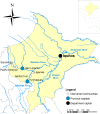Needs, acceptability, and value of humanitarian medical assistance in remote Peruvian Amazon riverine communities
- PMID: 25846293
- PMCID: PMC4458809
- DOI: 10.4269/ajtmh.14-0329
Needs, acceptability, and value of humanitarian medical assistance in remote Peruvian Amazon riverine communities
Abstract
Much debate exists regarding the need, acceptability, and value of humanitarian medical assistance. We conducted a cross-sectional study on 457 children under 5 years from four remote riverine communities in the Peruvian Amazon and collected anthropometric measures, blood samples (1-4 years), and stool samples. Focus groups and key informant interviews assessed perspectives regarding medical aid delivered by foreigners. The prevalence of stunting, anemia, and intestinal parasites was 20%, 37%, and 62%, respectively. Infection with multiple parasites, usually geohelminths, was detected in 41% of children. The prevalence of intestinal parasites both individual and polyparasitism increased with age. Participants from smaller communities less exposed to foreigners expressed lack of trust and fear of them. However, participants from all communities were positive about foreigners visiting to provide health support. Prevalent health needs such as parasitic infections and anemia may be addressed by short-term medical interventions. There is a perceived openness to and acceptability of medical assistance delivered by foreign personnel.
© The American Society of Tropical Medicine and Hygiene.
Figures
References
-
- Huerga H, Lopez-Velez R. Enfermedades infecciosas en el niño inmigrante. [Infectious diseases in the migrant child] Rev Pediatr Aten Primaria. 2002;4:73–80.
-
- World Health Organization . Removing Obstacles to Healthy Development. Geneva, Switzerland: World Health Organization; 1999.
-
- Hotez PJ, Molyneux DH, Fenwick A, Kumaresan J, Sachs SE, Sachs JD, Savioli L. Control of neglected tropical diseases. N Engl J Med. 2007;357:1018–1027. - PubMed
-
- Instituto Nacional de Estadistica e Informatica (INEI) DHS Survey Peru: 2000, 2005, 2006, 2007, 2008, 2009. Lima, Peru: Instituto Nacional de Estadistica e Informatica; 2010.
-
- Analysis of Health Situation of Loreto Region. Iquitos, Peru: Direccion de Epidemiologia, Direccion Regional de Salud Loreto; 2010.
Publication types
MeSH terms
Grants and funding
LinkOut - more resources
Full Text Sources
Other Literature Sources


